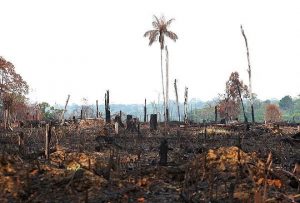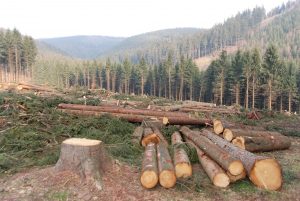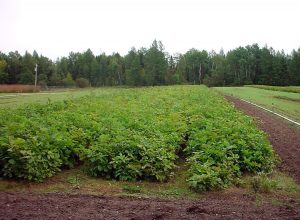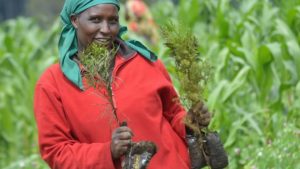Reforestation Matters
Written by Erin Yoo
Edited by Eunice Kim and Ashley Koca
Reforestation is one natural solution for fighting the climate crisis, but what is reforestation really? It is the active restoration of forests that have been cut down or otherwise harmed in some way. This may sound like a simple and fantastic idea — and it is. However, you can’t understand the true significance and importance of reforestation without understanding deforestation: the purposeful clearing of forests and a problem that every human, animal, and organism on this planet faces (National Geographic Society, 2019).
Deforestation and Forest Loss
The United States lost 36 million trees every year from 2009 to 2014, costing almost 100 million dollars each year (Nowak & Greenfield, 2018). Around the world, 10 billion trees are lost every year and in 2019, forests the size of football fields were lost every six seconds (“Protect,” n.d.; “The State of the World’s Forests,” 2020). The majority of deforestation happens in tropical rainforests, such as the Amazon. This makes an especially big impact on biodiversity, since rainforests are home to so many different species, many of which are only found in this specific habitat (National Geographic Society, 2019). Consequently, the State of the World’s Forests report from UN Food and Agriculture calls for vital action in combating current levels of deforestation and degradation (“The State of the World’s Forests,” 2020).
To make matters worse, the SEEG (Greenhouse Gas Emission and Removal Estimating System) study by Observatório do Clima (the Climate Observatory) in Brazil found that carbon emissions in the country in 2019 rose 9.6% compared to 2018, much of it due to deforestation in the Amazon (Reuters Staff, 2020). Specifically, 44% of those carbon emissions were a direct result of deforestation. The second highest cause included farming and cattle ranching (Reuters Staff, 2020). With these numbers, hopes to improve the climate can seem hopeless.
The biggest cause of deforestation is agriculture. Within the decade from 2000 to 2010, 73% of deforestation was caused by creating space for cattle ranchers, soy and oil palm crops, and other agricultural needs (“The State of the World’s Forests,” 2020). This included subsistence farming, whose purpose is to nourish only the farmers and their families instead of for commerce. Of all, cattle ranching is especially harmful in that it happens to slow down forest regeneration the most (“Forest Restoration in the Amazon,” n.d.). Additionally, slash-and-burn agriculture is also a major contributor to deforestation, which entails farmers burning big sections of forests to allow ash to fertilize land for crops. Wood ash lowers soil acidity by increasing pH, which is beneficial for many trees including junipers and conifers, and has commonly been used to nurture plants since the Roman Empire (Perry, n.d.). Burning trees puts more potassium and nutrients into the soil as well (Perry, n.d.). The problem is that this fertile soil only lasts for a couple of years, so farmers move to other plots of land, burning more and more forests as they go (National Geographic Society, 2019). Not only does this result in loss of trees, this adds even more carbon into the atmosphere. Firstly, carbon is chemically stored in wood, so it is released into the air when wood is burned (National Geographic Society, 2019). Moreover, combustion itself releases carbon dioxide. Increased carbon emissions is compounded by the fact that there are less trees left to absorb carbon dioxide through photosynthesis, so more carbon dioxide is left to accumulate in the atmosphere. Finally, road construction into forests is another significant cause of deforestation. Roads make it easier to further exploit land easier due to increased accessibility of the forests (National Geographic Society, 2019).
Forest loss also has natural causes. Insect infestations, storms, wildfires are some of the main reasons for dying forests, with the latter becoming more frequent and intense with climate change (Clancy, 2020). Larger wildfires also damage tree seed source, preventing forests from regrowing and reducing their resiliency, while leaving behind brush prone to facilitating even more forest fires (Clancy, 2020). In this way, wildfires can be self-perpetuating.
Figure 1
Aftermath of slash-and-burn agriculture in the Amazon

Note. Image credits to LA Times.
One important effect of deforestation, besides increased carbon emissions and reduced forest resiliency, is the acceleration of soil erosion. When trees are cut down, the roots that anchor soil in place are lost, and during rainfall, soil and vital nutrients for trees are easily swept away (Echolls, 2017). Over the last century and a half, 50% of the world’s topsoil has been lost, much of it due to soil erosion (Echolls, 2017; “Overview,” n.d.). Soil erosion decreases soil quality by reducing soil structure, nutrient levels, and salinity, leading to higher pollution in rivers, lower fish population, clogging of waterways, and worse floods (“Overview,” n.d.). It also causes more plants to be exposed to fires and results in drier forests, which can even transform into deserts (Echolls, 2017; National Geographic Society, 2019). A 2020 study by RUDN University found that deforestation results in lowered soil acidity and decreased organic nitrogen and carbon levels by 83%, to which the researchers then suggested that the lowered nutrient amounts may be caused by soil erosion (RUDN University, 2020). This further demonstrates the harmful effects of soil erosion on forests, and thus deforestation.
Figure 2
Picture of logged forest

Note. Image credits to National Geographic.
Perhaps one of the greatest inequalities as an effect of deforestation, regarding humanity, is its impact on those in poverty compared to those who aren’t. In general, the average person in poverty is more dependent on forests and their ecosystem services than those in higher income strata. The 2020 State of the World’s Forests report estimates that 252 million people around the world who live in forests and savannas make not even $1.25 USD per day (Food and Agriculture Organization of the United Nations, 2020). In Latin America, 82% of those of the poorest economic status depend on the forest for their livelihood.
Furthermore, deforestation is linked directly to human rights abuses (Clancy, 2020). Within 2016 alone, one thousand land defenders were attacked, harassed, imprisoned, and 281 advocates in twenty-five countries were killed (“Human Rights,” n.d.). Even more, logging corporations and groups, many illegal, often kidnap, kill, torture, and rape the Indigenous communities that live in the forests they deforest (“Human Rights,” n.d.). Though the issue of socioeconomic equality within the context of deforestation is complex to a great extent, it gives reason to realize how extensive deforestation is. Deforestation itself worsens global warming and climate change, resulting in more events that disproportionately affect those who are the poorest and the most vulnerable.
Reforestation
This means reforestation is necessitated and becoming ever more important because of rates of deforestation and destruction. In many ways, reforestation is much more feasible than other methods of fighting climate change. According to an article by Yale Environment 360, the World Resources Institute states there are 7.7 million square miles around the world today that can be restored (Pearce, 2019). In addition, a 2017 paper suggests that one-third of measures needed between now and 2030 to “save the climate” can come just from improving natural ecosystems such as through reforestation (Pearce, 2019). Even simply leaving plots of forests untouched and letting them flourish on their own through natural succession can provide immense benefits. When reforestation is needed, it is important to ensure that it is sustainable, resilient, and able to withstand more human activity. Otherwise, the same forest can become degraded again and again, requiring more energy and resources to reforest while harming the planet (Gustafson, n.d.).
Reforestation, distinct from restoration, can take on a variety of forms. Arguably, the most well-known and recognized method is simply to plant trees, but other methods include preventing fires and grazing, soil amelioration (improvement), soil erosion control, and weeding (“Forest Restoration & Reforestation,” n.d.). Another specific method is to cultivate nitrogen-fixing plants to improve soil quality and accelerate restoration of forests (Pearce, 2019). Throughout history, specifically in the Amazon, reforestation focused on establishing commercial plantations and growing crops like rubber, eucalyptus, pine, and other exotic woods to sell (“Forest Restoration in the Amazon,” n.d.). In the 1980s, it was mining companies who took charge of restoration and reforestation initiatives in the Amazon by using native species rather than crops for profit. The results of cultivating native species were seen in the forests’ biodiversity. However, this was fairly expensive, as work on one hectare alone would cost $2,500 (“Forest Restoration in the Amazon,” n.d.). Additionally, when planting native species, different benefits come depending on the native species. Lightly seeded species can recolonize a forest more easily, but are more vulnerable to predators and drought. On the other hand, larger seeded species survive at higher rates, but will not cover as much ground (“Forest Restoration in the Amazon region,” n.d.). Overall, the main goals of reforestation are to restore biodiversity, thus improving forest resiliency in the event of future destruction, and damaged ecosystems, regardless of which specific method is pursued (“Forest Restoration & Reforestation,” n.d.; “Why Plant,” n.d.).
Figure 3
Picture of Northern red oak seedlings in a nursery

Note. Image credits to USDA.
In general, reforestation requires substantial effort and labor, though it’s all worth it in the end. The National Forest Foundation outlines their process on their website: After deciding to pursue reforestation (instead of natural regeneration), seeds of native species are collected which sometimes entails climbing extremely tall trees. Those seeds are then planted and raised for one to two years in a controlled environment in a Forest Service nursery. The seedlings are then transported to their final homes in refrigerated containers until the mornings they are replanted. A professional tree planting crew member packs hundreds of seedlings into their bag and replants them on a hill in microsites, or locations where the seedlings are shaded from direct sunlight. The process is double-checked by the Forest Service by digging up random seedlings and confirming they were planted correctly, indicated by intact roots and other factors. Finally, the seedlings are monitored for five more years and subjected to maintenance activities like weeding out neighboring, competing plants (“How We Restore Forests,” n.d.). Though this system is specific to the U.S. National Forest Foundation, it can be applied to other reforestation initiatives and gives a glimpse of how reforestation is executed.
Ultimately, the reforestation and restoration of trees provides massive advantages to society and other organisms. Trees, and collectively, forests, take in carbon dioxide from the atmosphere and release oxygen. Specifically, they take in 3 billion tons of carbon from the atmosphere per year, or 30% of global fossil fuel emissions (“Reforestation and Afforestation,” 2019). But, besides this, they also provide a diverse multitude of other ecosystem services. As an example, the shade they provide is invaluable, especially during hot summer days. One study, according to a CNN article, found that trees could lower the temperature up to ten degrees Fahrenheit during daytime (Chillag, 2019). Thus, trees help reduce heat which can have significant economic benefits with decreased energy output coming from air conditioning, with the same article reporting that trees could save up to 4 billion dollars by reducing energy bills (Chillag, 2019). They also act as natural air and water filters, reduce floods, improve water quality, protect watersheds, prevent soil erosion, serve as protection from UV radiation, provide homes for wildlife, maintain and increase biodiversity, mitigate climate change, improve human health, and more—not to mention the cultural role trees play in society (“Forest Restoration & Reforestation,” n.d.; “Why Plant,” n.d.). In many cultures, trees represent identity to a certain place, mark important locations for politics, provide ingredients for dishes, and have a sacred status (“Cultural Values,” n.d.). In the United States, national forests are the single biggest source for freshwater for Americans while acting as homes for 3,000 vertebrae species and a countless number of invertebrate species. Plus, they counter 10-20% of carbon emissions emitted by the nation and are visited by 160 million people every year (“Why Plant,” n.d.).
Additionally, returning to the socioeconomic inequalities that deforestation perpetuates in many ways, reforestation provides immense benefits to the must underprivileged and poor. Planting trees can provide items to sell, such as fruits and nuts, creating income to send children to school and take care of other necessities (Farmbrough, 2020). Trees also help keep in moisture in the soil, reducing the damaging effect of droughts and also floods, where crops can get washed away (Farmbrough, 2020). Thus, there is hope. Deforestation can be combated with reforestation and restoration.
Conclusion
Restoring and reforesting land provides great opportunities for improving the climate and tackling climate change, especially as degradation continues. There have been and are many reforestation projects taking place today, such as the Trillion Tree Project, which aims to protect and plant one trillion trees by 2050 as a collaboration between some of the biggest wildlife conservation organizations in the world. Ecosia, an internet search engine, uses the money it makes from ad revenue to plant millions of trees. At this very moment, the moment this sentence is being written, 114,316,047 trees have been planted around the world by Ecosia. In the U.S., the National Forest Foundation is undertaking a campaign to plant fifty million trees in America’s National Forests, restoring tens of thousands of acres of wildlife habitat (“Why Plant,” n.d.). Initiative 20×20 has been working to restore twenty million hectares of land by 2020 in Latin America and the Caribbean as a larger part of the Bonn Challenge, which intends to restore 350 million hectares around the world by the next decade (“Initiative 20×20,” n.d.). In closing, it’s safe to say that although deforestation continues to be a grave issue on this planet, there is a feasible solution that is already being worked toward. Reforestation.
Figure 4
Woman planting seedlings in Kenya through Ecosia

Note. Image Credits to Ecosia.
References
Chillag, A. (2019, September 18). US cities are losing 36 million trees a year. Here’s why it matters and how you can stop it. CNN. https://www.cnn.com/2019/07/20/health/iyw-cities-losing-36-million-trees-how-to-help-trnd/index.html
Clancy, H. (2020, October). Talking Trees. Verge Weekly, 1
Cultural Values. (n.d.). Global Trees Campaign. https://globaltrees.org/threatened-trees/tree-values/cultural/
Echolls, T. (2017, April). Soil Erosion Due to Rainforest Deforestation. Sciencing. https://sciencing.com/soil-erosion-due-rainforest-deforestation-23042.html
Farmbrough, H. (2020, November). How The World’s Largest Green Search Engine Is Fighting Climate Change. Forbes. https://www.forbes.com/sites/heatherfarmbrough/2020/11/10/fighting-climate-change-with-the-worlds-largest-green-search-engine/?sh=76a19c33402
Food and Agriculture Organization of the United Nations. (2020). The State of the World’s Forests. https://wedocs.unep.org/bitstream/handle/20.500.11822/32472/WF20EN.pdf
Forest Restoration in the Amazon region. (n.d.). Global Forest Atlas. https://globalforestatlas.yale.edu/amazon/conservation-initiatives/forest-restoration
Forest Restoration & Reforestation. (n.d.). Global Forest Atlas. https://globalforestatlas.yale.edu/conservation/forest-restoration-reforestation
Gustafson, K. (n.d.). What is forest restoration and how do we do it well? World Wildlife. https://www.worldwildlife.org/stories/what-is-forest-restoration-and-how-do-we-do-it-well
How We Restore Forests. (n.d.). National Forest Foundation. https://www.nationalforests.org/get-involved/tree-planting-programs/how-we-restore-forests
Human Rights Impacts of Deforestation. (n.d.). Closing the Gap. https://rightsanddeforestation.org/policy-papers/human-rights-impacts-of-deforestation/
Initiative 20×20. (n.d.). World Resources Institute. https://www.wri.org/our-work/project/initiative-20×20
Overview. (n.d.). World Wildlife. https://www.worldwildlife.org/threats/soil-erosion-and-degradation
Pearce, F. (2019, May). Geoengineer the Planet? More Scientists Now Say It Must Be an Option. Yale Environment 360. https://e360.yale.edu/features/geoengineer-the-planet-more-scientists-now-say-it-must-be-an-option
Perry, L. (n.d.). Wood Ashes in Gardens. University of Vermont Extension. https://pss.uvm.edu/ppp/articles/woodash.html
National Geographic Society. (2019, July). Deforestation. National Geographic. https://www.nationalgeographic.org/encyclopedia/deforestation/
Nowak, D. J., & Greenfield, E. J. (2018, May). Declining urban and community tree cover in the United States. Urban Forestry & Urban Greening, 32, 32-55. https://doi.org/10.1016/j.ufug.2018.03.006
Protect. Restore. End deforestation. (n.d.). Trillion Trees. https://www.trilliontrees.org/
Reforestation and Afforestation [Carbon Sequestration 101]. (2019, June). CO2 Foundation. https://co2foundation.org/reforestation-and-afforestation/
Reuters Staff. (2020, November). Brazil’s Carbon Emissions Rose 9.6% in 2019 with Amazon deforestation – Study. Reuters. https://www.reuters.com/article/brazil-environment-idUSKBN27M28D
RUDN University. (2020, November). RUDN University soil scientist: Deforestation affects the bacterial composition of the soil. Eurekalert. https://www.eurekalert.org/pub_releases/2020-11/ru-rus110920.php
The State of the World’s Forests in 2020. (2020, June 19). One Tree Planted. https://onetreeplanted.org/blogs/stories/state-of-the-worlds-forests
Why Plant 50 Million Trees? (n.d.). National Forest Foundation. https://www.nationalforests.org/get-involved/tree-planting-programs/benefits-of-reforestation